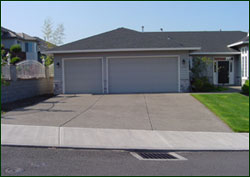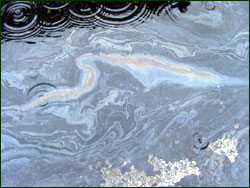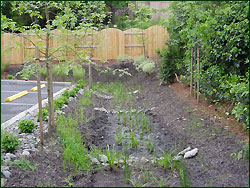|

The Problem
A Solution
The Stormwater Management Problem
Earth’s water continuously circulates from the atmosphere
to the land, from there into groundwater and surface water, and
then back to the atmosphere. This is called the water cycle, or
hydrologic cycle, and is key to understanding stormwater impacts.
In natural (undeveloped) conditions, rainfall infiltrates slowly
into the ground. Natural biologic processes cleanse the water as
it moves through vegetation and soil and into groundwater. Because
most Pacific Northwest rainstorms are not large enough to fully
saturate the soil, only a small percentage of rainwater flows over
the surface as runoff. What does become runoff usually travels at
a slow, meandering pace. Particles and sediments settle out along
the way, ridding the water of impurities before it flows into rivers
and streams.

The Hydrologic Cycle: Effects of Impervious Land
on Runoff Quality and Quantity
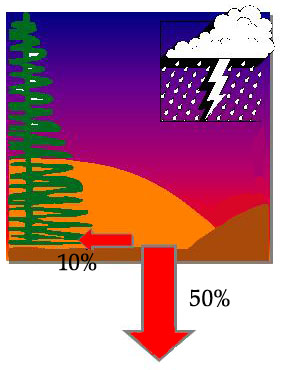
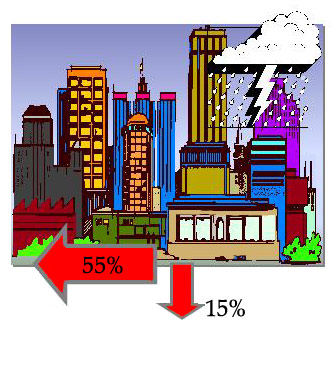
| In pre-development conditions, a large
percentage of precipitation infiltrates into the soil. A small
percentage remains on the surface as runoff. |
|
In post-development conditions, impervious
surfaces greatly reduce infiltration. A much larger percentage
of precipitation becomes surface runoff.
Diagram courtesy of NEMO
|
For Metro’s graphic version of development’s
impact on the hydrologic cycle click
here.
When
impervious area in a watershed reaches 10 percent, stream
ecosystems begin to show evidence of degradation. Coverage
of more than 30 percent is associated with significant degradation.
Developed urban areas typically have impervious surface coverage
of well over 30 percent. |
Development drastically alters these conditions. Impervious surfaces
such as buildings, roads, parking lots, and sidewalks prevent rain
from soaking into the ground. There is less vegetation to soak up,
store, and evaporate water. As a result, stormwater runoff over the
land surface greatly increases, even during small rainstorms. This
alteration of the water cycle has significant impacts to rivers and
streams:
 Increased
runoff volume and speed cause flooding and erosion and destroy natural
habitat. Increased
runoff volume and speed cause flooding and erosion and destroy natural
habitat.
 Because less
water infiltrates into the ground, less groundwater recharge occurs.
This reduces steam base flows, which is harmful to fish and aquatic
organisms. Because less
water infiltrates into the ground, less groundwater recharge occurs.
This reduces steam base flows, which is harmful to fish and aquatic
organisms.
 Impervious
surfaces retain heat, which increases runoff temperature during
warm weather. This in turn raises the temperature of the receiving
waters, negatively impacting aquatic life. Impervious
surfaces retain heat, which increases runoff temperature during
warm weather. This in turn raises the temperature of the receiving
waters, negatively impacting aquatic life.

| Stormwater
runoff –also called surface water runoff—is the
largest source of water pollution affecting Oregon’s rivers,
lakes, and streams. |
 Stormwater
runoff collects oil, fertilizers and pesticides, metals, chemicals,
sediments, bacteria, and other pollutants and carries them into
rivers and streams. Stormwater
runoff collects oil, fertilizers and pesticides, metals, chemicals,
sediments, bacteria, and other pollutants and carries them into
rivers and streams.
Traditional stormwater management basically seeks
to “get rid of” runoff. Gutters, drains, and pipes collect
runoff from impervious surfaces and convey it to discharge points.
Large volumes of untreated stormwater rapidly discharge into natural
water bodies.
Protecting our rivers and streams is vital for a great number of
uses, including fish and wildlife habitat, recreation, and drinking
water. As the region continues to grow and develop, the harmful
effects of excessive stormwater runoff will only increase—unless
we do things differently.
The Problem
A Solution
A Stormwater Management
Solution
Across the region and country many new developments are utilizing
different approaches that significantly lesson stormwater impacts.
Capturing, treating, and infiltrating stormwater on site is the
new focus. Stormwater management becomes an integral element of
site and building design, rather than a consequence or afterthought
of development. It’s an approach with both strong environmental
benefits and great possibilities to enhance developed or developing
properties.
Water quality friendly stormwater techniques involve one or more
of the following strategies:
 Reduce paved surfaces. This strategy promotes stormwater
infiltration into the ground and decreases surface runoff. It can
be accomplished by:
Reduce paved surfaces. This strategy promotes stormwater
infiltration into the ground and decreases surface runoff. It can
be accomplished by:
- Retaining the natural landscape – protecting and encouraging
trees and open space.
- Minimizing pavement – through approaches like narrow driveways,
parking lot spaces, and travel lanes.
- Using permeable surfaces – such as permeable pavement,
turf block, and gravel instead of concrete.
 Disconnect impervious areas. Any impervious area
that drains into the stormwater system is a “connected impervious
area.” These areas can be “disconnected” by directing
the runoff elsewhere. Most commonly residential downspouts are routinely
directed to landscaped areas or rain barrels.
Disconnect impervious areas. Any impervious area
that drains into the stormwater system is a “connected impervious
area.” These areas can be “disconnected” by directing
the runoff elsewhere. Most commonly residential downspouts are routinely
directed to landscaped areas or rain barrels.
 Intercept stormwater. Capturing rainwater before
it comes into contact with an impervious surface. Trees, ecoroofs
and roof gardens all intercept rainfall.
Intercept stormwater. Capturing rainwater before
it comes into contact with an impervious surface. Trees, ecoroofs
and roof gardens all intercept rainfall.
 Detain and infiltrate stormwater. Storing stormwater
to allow it to soak into the ground or move more slowly into the
storm system. Planter boxes, infiltration basins, swales, soakage
trenches, and drywells all provide infiltration.
Detain and infiltrate stormwater. Storing stormwater
to allow it to soak into the ground or move more slowly into the
storm system. Planter boxes, infiltration basins, swales, soakage
trenches, and drywells all provide infiltration.
 Filter stormwater. Filtering out pollutants as
stormwater moves through vegetated facilities such as planter boxes,
swales, filter strips, infiltration basins and sand filters.
Filter stormwater. Filtering out pollutants as
stormwater moves through vegetated facilities such as planter boxes,
swales, filter strips, infiltration basins and sand filters.
These processes realize significant benefits.
Runoff volume, speed, and temperature are reduced. Groundwater recharge
and stream base flows are replenished. The quality of runoff entering
rivers and streams is improved. The result is that development achieves
a better balance with the natural water cycle and becomes water
quality friendly.
Added Value
In addition to improving the health of the region’s water
resources, techniques that control stormwater runoff on site can
offer many other advantages:
- Improve air quality by filtering out
air pollutants.
- Reduce air temperature through shading
and decreased impervious surfaces.
- Provide wildlife habitat.
- Add aesthetic appeal and increase property
value.
- Reduce energy costs by insulating and
shading buildings.
- Collect water for reuse, reducing the
amount of water we use.
- Help meet the challenge of allowing
for development while preserving water quality which directly
impacts a region’s livability.
|



